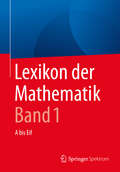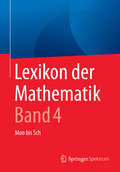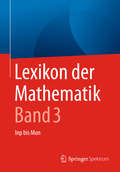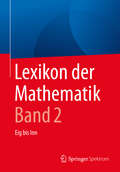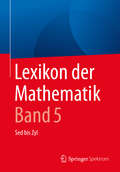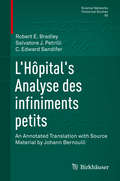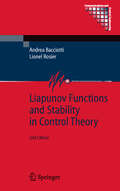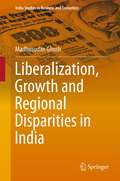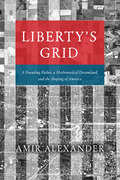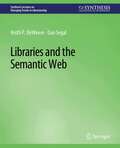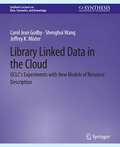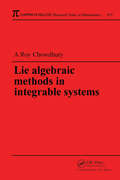- Table View
- List View
Lexical Collocation Analysis: Advances and Applications (Quantitative Methods in the Humanities and Social Sciences)
by Pascual Cantos-Gómez Moisés Almela-SánchezThis book re-examines the notion of word associations, more precisely collocations. It attempts to come to a potentially more generally applicable definition of collocation and how to best extract, identify and measure collocations. The book highlights the role played by (i) automatic linguistic annotation (part-of-speech tagging, syntactic parsing, etc.), (ii) using semantic criteria to facilitate the identification of collocations, (iii) multi-word structured, instead of the widespread assumption of bipartite collocational structures, for capturing the intricacies of the phenomenon of syntagmatic attraction, (iv) considering collocation and valency as near neighbours in the lexis-grammar continuum and (v) the mathematical properties of statistical association measures in the automatic extraction of collocations from corpora. This book is an ideal guide to the use of statistics in collocation analysis and lexicography, as well as a practical text to the development of skills in the application of computational lexicography. Lexical Collocation Analysis: Advances and Applications begins with a proposal for integrating both collocational and valency phenomena within the overarching theoretical framework of construction grammar. Next the book makes the case for integrating advances in syntactic parsing and in collocational analysis. Chapter 3 offers an innovative look at complementing corpus data and dictionaries in the identification of specific types of collocations consisting of restricted predicate-argument combinations. This strategy complements corpus collocational data with network analysis techniques applied to dictionary entries. Chapter 4 explains the potential of collocational graphs and networks both as a visualization tool and as an analytical technique. Chapter 5 introduces MERGE (Multi-word Expressions from the Recursive Grouping of Elements), a data-driven approach to the identification and extraction of multi-word expressions from corpora. Finally the book concludes with an analysis and evaluation of factors influencing the performance of collocation extraction methods in parsed corpora.
Lexikon der Mathematik: A bis Eif
by Guido WalzDas fünfbändige "Lexikon der Mathematik" bietet in insgesamt ca.17.000 Stichworteinträgen einen umfassenden Überblick über die moderne Mathematik, ihre Fachterminologie und ihre Anwendungen. Die behandelten Fachgebiete reichen von klassischen Themengebieten wie Geometrie, Zahlentheorie und Geschichte der Mathematik – über Numerische Mathematik, Graphentheorie, Versicherungsmathematik und Optimierung – bis hin zu modernen Anwendungsbereichen wie etwa Wavelets, Codierungstheorie oder Neuronalen Netzen. Besondere Berücksichtigung finden die Biographien bedeutender Wissenschaftler von der Antike bis zur Gegenwart. Dadurch wird dem Umstand Rechnung getragen, dass gerade in der Mathematik eine Fülle von Verfahren, Methoden oder auch Lehrsätzen existieren, die nach berühmten Persönlichkeiten benannt sind – z.B. abelsche Gruppe, Satz des Pythagoras und euklidischer Algorithmus. Ein Charakteristikum des Werkes sind die zahlreichen Essays von international anerkannten Fachleuten, in denen entweder ein mathematisches Fachgebiet übersichtlich vorgestellt oder ein "Highlight" der Mathematik besonders gewürdigt wird. Im vorliegenden ersten Band finden Sie unter anderem Essays zu den Themen Arabische Mathematik und Codierungstheorie. Hauptzielgruppen des Lexikons sind neben Mathematikern in Schule, Hochschule und Wirtschaft vor allem Fachleute und Wissenschaftler benachbarter Disziplinen sowie mathematisch interessierte Laien.Mit der vorliegenden Neuauflage wird das in Umfang und Qualität auf dem deutschsprachigen Markt einzigartige Werk – 15 Jahre nach der Erstveröffentlichung – wieder lieferbar gemacht. Aus diesem Anlass wurden kleinere Ungenauigkeiten korrigiert sowie die Lebensdaten einiger inzwischen leider verstorbener Persönlichkeiten aktualisiert. Aufgrund rechtlicher Unklarheiten mussten die im Erstdruck enthaltenen Porträtabbildungen bekannter Mathematikerinnen und Mathematiker leider entfernt werden.
Lexikon der Mathematik: Moo bis Sch
by Guido WalzDas fünfbändige "Lexikon der Mathematik" bietet in insgesamt ca.17.000 Stichworteinträgen einen umfassenden Überblick über die moderne Mathematik, ihre Fachterminologie und ihre Anwendungen. Die behandelten Fachgebiete reichen von klassischen Themengebieten wie Geometrie, Zahlentheorie und Geschichte der Mathematik – über Numerische Mathematik, Graphentheorie, Versicherungsmathematik und Optimierung – bis hin zu modernen Anwendungsbereichen wie etwa Wavelets, Codierungstheorie oder Neuronalen Netzen. Besondere Berücksichtigung finden die Biographien bedeutender Wissenschaftler von der Antike bis zur Gegenwart. Dadurch wird dem Umstand Rechnung getragen, dass gerade in der Mathematik eine Fülle von Verfahren, Methoden oder auch Lehrsätzen existieren, die nach berühmten Persönlichkeiten benannt sind – z.B. abelsche Gruppe, Satz des Pythagoras und euklidischer Algorithmus. Ein Charakteristikum des Werkes sind die zahlreichen Essays von international anerkannten Fachleuten, in denen entweder ein mathematisches Fachgebiet übersichtlich vorgestellt oder ein "Highlight" der Mathematik besonders gewürdigt wird. Im vorliegenden vierten Band finden Sie unter anderem Essays über die Zahl und den Satz des Pythagoras. Hauptzielgruppen des Lexikons sind neben Mathematikern in Schule, Hochschule und Wirtschaft vor allem Fachleute und Wissenschaftler benachbarter Disziplinen sowie mathematisch interessierte Laien.Mit der vorliegenden Neuauflage wird das in Umfang und Qualität auf dem deutschsprachigen Markt einzigartige Werk – 15 Jahre nach der Erstveröffentlichung – wieder lieferbar gemacht. Aus diesem Anlass wurden kleinere Ungenauigkeiten korrigiert sowie die Lebensdaten einiger inzwischen leider verstorbener Persönlichkeiten aktualisiert. Aufgrund rechtlicher Unklarheiten mussten die im Erstdruck enthaltenen Porträtabbildungen bekannter Mathematikerinnen und Mathematiker leider entfernt werden.
Lexikon der Mathematik: Inp bis Mon
by Guido WalzDas fünfbändige "Lexikon der Mathematik" bietet in insgesamt ca.17.000 Stichworteinträgen einen umfassenden Überblick über die moderne Mathematik, ihre Fachterminologie und ihre Anwendungen. Die behandelten Fachgebiete reichen von klassischen Themengebieten wie Geometrie, Zahlentheorie und Geschichte der Mathematik – über Numerische Mathematik, Graphentheorie, Versicherungsmathematik und Optimierung – bis hin zu modernen Anwendungsbereichen wie etwa Wavelets, Codierungstheorie oder Neuronalen Netzen. Besondere Berücksichtigung finden die Biographien bedeutender Wissenschaftler von der Antike bis zur Gegenwart. Dadurch wird dem Umstand Rechnung getragen, dass gerade in der Mathematik eine Fülle von Verfahren, Methoden oder auch Lehrsätzen existieren, die nach berühmten Persönlichkeiten benannt sind – z.B. abelsche Gruppe, Satz des Pythagoras und euklidischer Algorithmus. Ein Charakteristikum des Werkes sind die zahlreichen Essays von international anerkannten Fachleuten, in denen entweder ein mathematisches Fachgebiet übersichtlich vorgestellt oder ein "Highlight" der Mathematik besonders gewürdigt wird. Im vorliegenden dritten Band finden Sie unter anderem Essays zu den Themen Kosmologie und Mathematik im 20. Jahrhundert. Hauptzielgruppen des Lexikons sind neben Mathematikern in Schule, Hochschule und Wirtschaft vor allem Fachleute und Wissenschaftler benachbarter Disziplinen sowie mathematisch interessierte Laien.Mit der vorliegenden Neuauflage wird das in Umfang und Qualität auf dem deutschsprachigen Markt einzigartige Werk – 15 Jahre nach der Erstveröffentlichung – wieder lieferbar gemacht. Aus diesem Anlass wurden kleinere Ungenauigkeiten korrigiert sowie die Lebensdaten einiger inzwischen leider verstorbener Persönlichkeiten aktualisiert. Aufgrund rechtlicher Unklarheiten mussten die im Erstdruck enthaltenen Porträtabbildungen bekannter Mathematikerinnen und Mathematiker leider entfernt werden.
Lexikon der Mathematik: Eig bis Inn
by Guido WalzDas fünfbändige "Lexikon der Mathematik" bietet in insgesamt ca.17.000 Stichworteinträgen einen umfassenden Überblick über die moderne Mathematik, ihre Fachterminologie und ihre Anwendungen. Die behandelten Fachgebiete reichen von klassischen Themengebieten wie Geometrie, Zahlentheorie und Geschichte der Mathematik – über Numerische Mathematik, Graphentheorie, Versicherungsmathematik und Optimierung – bis hin zu modernen Anwendungsbereichen wie etwa Wavelets, Codierungstheorie oder Neuronalen Netzen. Besondere Berücksichtigung finden die Biographien bedeutender Wissenschaftler von der Antike bis zur Gegenwart. Dadurch wird dem Umstand Rechnung getragen, dass gerade in der Mathematik eine Fülle von Verfahren, Methoden oder auch Lehrsätzen existieren, die nach berühmten Persönlichkeiten benannt sind – z.B. abelsche Gruppe, Satz des Pythagoras und euklidischer Algorithmus. Ein Charakteristikum des Werkes sind die zahlreichen Essays von international anerkannten Fachleuten, in denen entweder ein mathematisches Fachgebiet übersichtlich vorgestellt oder ein "Highlight" der Mathematik besonders gewürdigt wird. Im vorliegenden zweiten Band finden Sie unter anderem Essays zu den Themen Fermatsche Vermutung und Humor in der Mathematik. Hauptzielgruppen des Lexikons sind neben Mathematikern in Schule, Hochschule und Wirtschaft vor allem Fachleute und Wissenschaftler benachbarter Disziplinen sowie mathematisch interessierte Laien.Mit der vorliegenden Neuauflage wird das in Umfang und Qualität auf dem deutschsprachigen Markt einzigartige Werk – 15 Jahre nach der Erstveröffentlichung – wieder lieferbar gemacht. Aus diesem Anlass wurden kleinere Ungenauigkeiten korrigiert sowie die Lebensdaten einiger inzwischen leider verstorbener Persönlichkeiten aktualisiert. Aufgrund rechtlicher Unklarheiten mussten die im Erstdruck enthaltenen Porträtabbildungen bekannter Mathematikerinnen und Mathematiker leider entfernt werden.
Lexikon der Mathematik: Sed bis Zyl
by Guido WalzDas fünfbändige "Lexikon der Mathematik" bietet in insgesamt ca.17.000 Stichworteinträgen einen umfassenden Überblick über die moderne Mathematik, ihre Fachterminologie und ihre Anwendungen. Die behandelten Fachgebiete reichen von klassischen Themengebieten wie Geometrie, Zahlentheorie und Geschichte der Mathematik – über Numerische Mathematik, Graphentheorie, Versicherungsmathematik und Optimierung – bis hin zu modernen Anwendungsbereichen wie etwa Wavelets, Codierungstheorie oder Neuronalen Netzen. Besondere Berücksichtigung finden die Biographien bedeutender Wissenschaftler von der Antike bis zur Gegenwart. Dadurch wird dem Umstand Rechnung getragen, dass gerade in der Mathematik eine Fülle von Verfahren, Methoden oder auch Lehrsätzen existieren, die nach berühmten Persönlichkeiten benannt sind – z.B. abelsche Gruppe, Satz des Pythagoras und euklidischer Algorithmus. Ein Charakteristikum des Werkes sind die zahlreichen Essays von international anerkannten Fachleuten, in denen entweder ein mathematisches Fachgebiet übersichtlich vorgestellt oder ein "Highlight" der Mathematik besonders gewürdigt wird. Im vorliegenden fünften Band finden Sie unter anderem Essays zu den Themen Stringtheorie und Wavelets. Hauptzielgruppen des Lexikons sind neben Mathematikern in Schule, Hochschule und Wirtschaft vor allem Fachleute und Wissenschaftler benachbarter Disziplinen sowie mathematisch interessierte Laien.Mit der vorliegenden Neuauflage wird das in Umfang und Qualität auf dem deutschsprachigen Markt einzigartige Werk – 15 Jahre nach der Erstveröffentlichung – wieder lieferbar gemacht. Aus diesem Anlass wurden kleinere Ungenauigkeiten korrigiert sowie die Lebensdaten einiger inzwischen leider verstorbener Persönlichkeiten aktualisiert. Aufgrund rechtlicher Unklarheiten mussten die im Erstdruck enthaltenen Porträtabbildungen bekannter Mathematikerinnen und Mathematiker leider entfernt werden.
Lexis in Demography (SpringerBriefs in Population Studies)
by Klára Hulíková Tesárková Olga KurtinováThis book explores the life of economist and social scientist Wilhelm Lexis and the key demographic instrument named after him: the Lexis diagram. It describes this vital tool, which helps demographers visualize data, and examines its various forms through a specially designed example. As a result, readers get to see the Lexis diagram in practice and gain first-hand insight into its different forms.The authors first present a brief description of the life of W. Lexis with information about his childhood, studies, and work. Coverage details the places closely related to him as well as his working positions. It also lists and characterizes his publications.The book then goes on to summarize and describe the chronological development of the Lexis diagram, from initial developments through the specific contributions of W. Lexis to the refinements of those who followed. Throughout, it clearly describes as well as graphically and practically illustrates all the different versions of the diagram covered.Next, readers are presented with contemporary practical applications, including: Statistical Analysis System (SAS), R, and Stata software as well as selected key-studies from demographic, epidemiologic, and migration research.The Lexis diagram is an essential tool for working correctly with demographic data. This book commemorates the man who helped to develop these diagrams and his unquestionable influence on demography. It also provides readers with deep knowledge and insights into this basic, yet important, tool.
LHC Phenomenology (Scottish Graduate Series)
by Einan Gardi Nigel Glover Aidan RobsonThis book covers a very broad spectrum of experimental and theoretical activity in particle physics, from the searches for the Higgs boson and physics beyond the Standard Model, to detailed studies of Quantum Chromodynamics, the B-physics sectors and the properties of hadronic matter at high energy density as realised in heavy-ion collisions.Starting with a basic introduction to the Standard Model and its most likely extensions, the opening section of the book presents an overview of the theoretical and phenomenological framework of hadron collisions and current theoretical models of frontier physics. In part II, discussion of the theory is supplemented by chapters on the detector capabilities and search strategies, as well as an overview of the main detector components, the initial calibration procedures and physics samples and early LHC results. Part III completes the volume with a description of the physics behind Monte Carlo event generators and a broad introduction to the main statistical methods used in high energy physics.LHC Phenomenology covers all of these topics at a pedagogical level, with the aim of providing young particle physicists with the basic tools required for future work on the various LHC experiments. It will also serve as a useful reference text for those working in the field.
L’Hôpital's Analyse des infiniments petits: An Annotated Translation with Source Material by Johann Bernoulli (Science Networks. Historical Studies #50)
by Robert E Bradley Salvatore J. Petrilli C. Edward SandiferThis monograph is an annotated translation of what is considered to be the world’s first calculus textbook, originally published in French in 1696. That anonymously published textbook on differential calculus was based on lectures given to the Marquis de l’Hôpital in 1691-2 by the great Swiss mathematician, Johann Bernoulli. In the 1920s, a copy of Bernoulli’s lecture notes was discovered in a library in Basel, which presented the opportunity to compare Bernoulli’s notes, in Latin, to l’Hôpital’s text in French. The similarities are remarkable, but there is also much in l’Hôpital’s book that is original and innovative.This book offers the first English translation of Bernoulli's notes, along with the first faithful English translation of l’Hôpital’s text, complete with annotations and commentary. Additionally, a significant portion of the correspondence between l’Hôpital and Bernoulli has been included, also for the fi rst time in English translation.This translation will provide students and researchers with direct access to Bernoulli’s ideas and l’Hôpital’s innovations. Both enthusiasts and scholars of the history of science and the history of mathematics will fi nd food for thought in the texts and notes of the Marquis de l’Hôpital and his teacher, Johann Bernoulli.
Liaison, Schottky Problem and Invariant Theory: Remembering Federico Gaeta (Progress in Mathematics #280)
by Maria Emilia Alonso Enrique Arrondo Raquel Mallavibarrena Ignacio SolsFederico Gaeta (1923–2007) was a Spanish algebraic geometer who was a student of Severi. He is considered to be one of the founders of linkage theory, on which he published several key papers. After many years abroad he came back to Spain in the 1980s. He spent his last period as a professor at Universidad Complutense de Madrid. In gratitude to him, some of his personal and mathematically close persons during this last station, all of whom bene?ted in one way or another by his ins- ration, have joined to edit this volume to keep his memory alive. We o?er in it surveys and original articles on the three main subjects of Gaeta’s interest through his mathematical life. The volume opens with a personal semblance by Ignacio Sols and a historical presentation by Ciro Ciliberto of Gaeta’s Italian period. Then it is divided into three parts, each of them devoted to a speci?c subject studied by Gaeta and coordinated by one of the editors. For each part, we had the advice of another colleague of Federico linked to that particular subject, who also contributed with a short survey. The ?rst part, coordinated by E. Arrondo with the advice of R.M.
Liapunov Functions and Stability in Control Theory (Communications and Control Engineering)
by Andrea Bacciotti Lionel RosierThis book presents a modern and self-contained treatment of the Liapunov method for stability analysis, in the framework of mathematical nonlinear control theory. A Particular focus is on the problem of the existence of Liapunov functions (converse Liapunov theorems) and their regularity, whose interest is especially motivated by applications to automatic control. Many recent results in this area have been collected and presented in a systematic way. Some of them are given in extended, unified versions and with new, simpler proofs. In the 2nd edition of this successful book several new sections were added and old sections have been improved, e.g., about the Zubovs method, Liapunov functions for discontinuous systems and cascaded systems. Many new examples, explanations and figures were added making this book accessible and well readable for engineers as well as mathematicians.
Liber Mahameleth: A 12th-century Mathematical Treatise (Sources and Studies in the History of Mathematics and Physical Sciences)
by Jacques SesianoThe Liber mahameleth is a work in Latin written in the mid-12th century based (mainly) on Arabic sources from Islamic Spain. It is now our principal source on mathematics in Islamic Spain at that time; There are few extant Arabic texts and no one is as complete as the LM. It is also the second largest mathematical work from the Latin Middle Ages (the other is by Fibonacci, some 50 years later).Since the three main manuscripts preserving it are incomplete and there are many scribal errors, a reliable Latin text has been established, which reports (in notes) the various readings of the manuscripts and the errors in them. This is how a so-called critical edition is made. This edition of the Latin text is preceded by General Introduction, describing the various manuscripts, the content of the work and what we know about its author.Part Two of the volume is a translation of the text and ends with a glossary of Latin terms. The glossary will be of great importance for the knowledge of Latin scientific terms from that time, since there is no other mathematical text of this size from the 12th century. Part Three begins with a short introduction and then analyzes all the problems from the text, with a summary of the mathematical methods involved in each chapter. The commentary is a companion to the translation and explains the author's solving methods.
Liberalization, Growth and Regional Disparities in India (India Studies in Business and Economics)
by Madhusudan GhoshUpon the backdrop of impressive progress made by the Indian economy during the last two decades after the large-scale economic reforms in the early 1990s, this book evaluates the performance of the economy on some income and non-income dimensions of development at the national, state and sectoral levels. It examines regional economic growth and inequality in income originating from agriculture, industry and services. In view of the importance of the agricultural sector, despite its declining share in gross domestic product, it evaluates the performance of agricultural production and the impact of agricultural reforms on spatial integration of food grain markets. It studies rural poverty, analyzing the trend in employment, the trickle-down process and the inclusiveness of growth in rural India. It also evaluates the impact of microfinance, as an instrument of financial inclusion, on the socio-economic conditions of rural households. Lastly, it examines the relative performance of fifteen major states of India in terms of education, health and human development. An important feature of the book is that it approaches these issues, applying rigorously advanced econometric methods, and focusing primarily on their regional disparities during the post-reform period vis-à-vis the pre-reform period. It offers important results to guide policies for future development.
Liberty's Grid: A Founding Father, a Mathematical Dreamland, and the Shaping of America
by Amir AlexanderThe surprising history behind a ubiquitous facet of the United States: the gridded landscape. Seen from an airplane, much of the United States appears to be a gridded land of startling uniformity. Perpendicular streets and rectangular fields, all precisely measured and perfectly aligned, turn both urban and rural America into a checkerboard landscape that stretches from horizon to horizon. In evidence throughout the country, but especially the West, the pattern is a hallmark of American life. One might consider it an administrative convenience—an easy way to divide land and lay down streets—but it is not. The colossal grid carved into the North American continent, argues historian and writer Amir Alexander, is a plan redolent with philosophical and political meaning. In 1784 Thomas Jefferson presented Congress with an audacious scheme to reshape the territory of the young United States. All western lands, he proposed, would be inscribed with a single rectilinear grid, transforming the natural landscape into a mathematical one. Following Isaac Newton and John Locke, he viewed mathematical space as a blank slate on which anything is possible and where new Americans, acting freely, could find liberty. And if the real America, with its diverse landscapes and rich human history, did not match his vision, then it must be made to match it. From the halls of Congress to the open prairies, and from the fight against George III to the Trail of Tears, Liberty’s Grid tells the story of the battle between grid makers and their opponents. When Congress endorsed Jefferson’s plan, it set off a struggle over American space that has not subsided. Transcendentalists, urban reformers, and conservationists saw the grid not as a place of possibility but as an artificial imposition that crushed the human spirit. Today, the ideas Jefferson associated with the grid still echo through political rhetoric about the country’s founding, and competing visions for the nation are visible from Manhattan avenues and Kansan pastures to Yosemite’s cliffs and suburbia’s cul-de-sacs. An engrossing read, Liberty’s Grid offers a powerful look at the ideological conflict written on the landscape.
Liberty's Grid: A Founding Father, a Mathematical Dreamland, and the Shaping of America
by Amir AlexanderThe surprising history behind a ubiquitous facet of the United States: the gridded landscape. Seen from an airplane, much of the United States appears to be a gridded land of startling uniformity. Perpendicular streets and rectangular fields, all precisely measured and perfectly aligned, turn both urban and rural America into a checkerboard landscape that stretches from horizon to horizon. In evidence throughout the country, but especially the West, the pattern is a hallmark of American life. One might consider it an administrative convenience—an easy way to divide land and lay down streets—but it is not. The colossal grid carved into the North American continent, argues historian and writer Amir Alexander, is a plan redolent with philosophical and political meaning. In 1784 Thomas Jefferson presented Congress with an audacious scheme to reshape the territory of the young United States. All western lands, he proposed, would be inscribed with a single rectilinear grid, transforming the natural landscape into a mathematical one. Following Isaac Newton and John Locke, he viewed mathematical space as a blank slate on which anything is possible and where new Americans, acting freely, could find liberty. And if the real America, with its diverse landscapes and rich human history, did not match his vision, then it must be made to match it. From the halls of Congress to the open prairies, and from the fight against George III to the Trail of Tears, Liberty’s Grid tells the story of the battle between grid makers and their opponents. When Congress endorsed Jefferson’s plan, it set off a struggle over American space that has not subsided. Transcendentalists, urban reformers, and conservationists saw the grid not as a place of possibility but as an artificial imposition that crushed the human spirit. Today, the ideas Jefferson associated with the grid still echo through political rhetoric about the country’s founding, and competing visions for the nation are visible from Manhattan avenues and Kansan pastures to Yosemite’s cliffs and suburbia’s cul-de-sacs. An engrossing read, Liberty’s Grid offers a powerful look at the ideological conflict written on the landscape.
Libraries and the Semantic Web (Synthesis Lectures on Emerging Trends in Librarianship)
by Keith P. DeWeese Dan SegalThis book covers the concept of the Semantic Web—what it is, the components that comprise it, including Linked Data, and the various ways that libraries are engaged in contributing to its development in making library resources and services ever more accessible to end-users.
Library Linked Data in the Cloud: OCLC's Experiments with New Models of Resource Description (Synthesis Lectures on Data, Semantics, and Knowledge)
by Carol Jean Godby Shenghui Wang Jeffrey MixterThis book describes OCLC's contributions to the transformation of the Internet from a web of documents to a Web of Data. The new Web is a growing `cloud' of interconnected resources that identify the things people want to know about when they approach the Internet with an information need. The linked data architecture has achieved critical mass just as it has become clear that library standards for resource description are nearing obsolescence. Working for the world's largest library cooperative, OCLC researchers have been active participants in the development of next-generation standards for library resource description. By engaging with an international community of library and Web standards experts, they have published some of the most widely used RDF datasets representing library collections and librarianship. This book focuses on the conceptual and technical challenges involved in publishing linked data derived from traditional library metadata. This transformation is a high priority because most searches for information start not in the library, nor even in a Web-accessible library catalog, but elsewhere on the Internet. Modeling data in a form that the broader Web understands will project the value of libraries into the Digital Information Age. The exposition is aimed at librarians, archivists, computer scientists, and other professionals interested in modeling bibliographic descriptions as linked data. It aims to achieve a balanced treatment of theory, technical detail, and practical application.
Lichtspiele in der Luft: Atmosphärische Optik für Einsteiger
by Michael VollmerWir haben tagtäglich die atmosphärische Optik vor Augen - und übersehen sie geflissentlich. Dabei führt uns der Himmel anschaulich vor, was mit dem Licht passiert, wenn es an Wassertropfen oder Rauch gestreut wird und dort, wo eigentlich nichts ist als mehr oder weniger reine Luft, bunte Bilder an den Himmel zaubert. Sonnenuntergänge, Regenbögen, Polarlichter, Aureolen und Glorien - eine Art Hof oder Heiligenschein - oder Fata morganas werden in Michael Vollmers reich illustriertem und klar verständlichem Buch zum natürlichen Labor für physikalische Entdeckungen - und man wird staunen, wie viel Physik man plötzlich kann - und die ist keine Fata Morgana.
The Lidov-Kozai Effect - Applications in Exoplanet Research and Dynamical Astronomy (Astrophysics and Space Science Library #441)
by Ivan I. ShevchenkoThis book deals with an effect in celestial mechanics that has become quite important in exoplanet research. The Lidov-Kozai effect reveals itself in coherent periodic variations (which can be very large) of the inclination and eccentricity of an orbiting body in the presence of an inclined perturber. The effect is known to be important in the motion of many asteroids and planetary satellites. What is more, now it attracts more and more interest in the astronomical and astrophysical community due to its relevance for many exoplanetary systems. Recent years witnessed major advancements in its theory. It would be no exaggeration to say that nowadays the Lidov-Kozai effect becomes one of the most studied astrophysical effects. This book covers the multitude of the Lidov-Kozai effect’s modern applications and its theory developments. It will be useful for researchers and students working in astrophysics, celestial mechanics, stellar dynamics, theoretical mechanics, space missions design, depending on the interests of the reader. The book is self-contained. It provides the full detailed coverage of the effect’s theory and applications.
Lie Algebraic Methods in Integrable Systems
by Amit K. Roy-ChowdhuryOver the last thirty years, the subject of nonlinear integrable systems has grown into a full-fledged research topic. In the last decade, Lie algebraic methods have grown in importance to various fields of theoretical research and worked to establish close relations between apparently unrelated systems. The various ideas associated with Lie algebra and Lie groups can be used to form a particularly elegant approach to the properties of nonlinear systems. In this volume, the author exposes the basic techniques of using Lie algebraic concepts to explore the domain of nonlinear integrable systems. His emphasis is not on developing a rigorous mathematical basis, but on using Lie algebraic methods as an effective tool.The book begins by establishing a practical basis in Lie algebra, including discussions of structure Lie, loop, and Virasor groups, quantum tori and Kac-Moody algebras, and gradation. It then offers a detailed discussion of prolongation structure and its representation theory, the orbit approach-for both finite and infinite dimension Lie algebra. The author also presents the modern approach to symmetries of integrable systems, including important new ideas in symmetry analysis, such as gauge transformations, and the "soldering" approach. He then moves to Hamiltonian structure, where he presents the Drinfeld-Sokolov approach, the Lie algebraic approach, Kupershmidt's approach, Hamiltonian reductions and the Gelfand Dikii formula. He concludes his treatment of Lie algebraic methods with a discussion of the classical r-matrix, its use, and its relations to double Lie algebra and the KP equation.
Lie Algebraic Methods in Integrable Systems
by Amit K. Roy-ChowdhuryOver the last thirty years, the subject of nonlinear integrable systems has grown into a full-fledged research topic. In the last decade, Lie algebraic methods have grown in importance to various fields of theoretical research and worked to establish close relations between apparently unrelated systems. The various ideas associated with Lie algebra and Lie groups can be used to form a particularly elegant approach to the properties of nonlinear systems. In this volume, the author exposes the basic techniques of using Lie algebraic concepts to explore the domain of nonlinear integrable systems. His emphasis is not on developing a rigorous mathematical basis, but on using Lie algebraic methods as an effective tool.The book begins by establishing a practical basis in Lie algebra, including discussions of structure Lie, loop, and Virasor groups, quantum tori and Kac-Moody algebras, and gradation. It then offers a detailed discussion of prolongation structure and its representation theory, the orbit approach-for both finite and infinite dimension Lie algebra. The author also presents the modern approach to symmetries of integrable systems, including important new ideas in symmetry analysis, such as gauge transformations, and the "soldering" approach. He then moves to Hamiltonian structure, where he presents the Drinfeld-Sokolov approach, the Lie algebraic approach, Kupershmidt's approach, Hamiltonian reductions and the Gelfand Dikii formula. He concludes his treatment of Lie algebraic methods with a discussion of the classical r-matrix, its use, and its relations to double Lie algebra and the KP equation.
Lie Algebras: Madison 1987. Proceedings of a Workshop held in Madison, Wisconsin, August 23-28, 1987 (Lecture Notes in Mathematics #1373)
by Georgia Benkart J. Marshall OsbornDuring the academic year 1987-1988 the University of Wisconsin in Madison hosted a Special Year of Lie Algebras. A Workshop on Lie Algebras, of which these are the proceedings, inaugurated the special year. The principal focus of the year and of the workshop was the long-standing problem of classifying the simple finite-dimensional Lie algebras over algebraically closed field of prime characteristic. However, other lectures at the workshop dealt with the related areas of algebraic groups, representation theory, and Kac-Moody Lie algebras. Fourteen papers were presented and nine of these (eight research articles and one expository article) make up this volume.
Lie Algebras and Algebraic Groups (Springer Monographs in Mathematics)
by Patrice Tauvel Rupert W. YuDevoted to the theory of Lie algebras and algebraic groups, this book includes a large amount of commutative algebra and algebraic geometry so as to make it as self-contained as possible. The aim of the book is to assemble in a single volume the algebraic aspects of the theory, so as to present the foundations of the theory in characteristic zero. Detailed proofs are included, and some recent results are discussed in the final chapters.
Lie Algebras and Applications (Lecture Notes in Physics #891)
by Francesco IachelloThis course-based primer provides an introduction to Lie algebras and some of their applications to the spectroscopy of molecules, atoms, nuclei and hadrons. In the first part, it concisely presents the basic concepts of Lie algebras, their representations and their invariants. The second part includes a description of how Lie algebras are used in practice in the treatment of bosonic and fermionic systems. Physical applications considered include rotations and vibrations of molecules (vibron model), collective modes in nuclei (interacting boson model), the atomic shell model, the nuclear shell model, and the quark model of hadrons. One of the key concepts in the application of Lie algebraic methods in physics, that of spectrum generating algebras and their associated dynamic symmetries, is also discussed. The book highlights a number of examples that help to illustrate the abstract algebraic definitions and includes a summary of many formulas of practical interest, such as the eigenvalues of Casimir operators, and the dimensions of the representations of all classical Lie algebras.For this new edition, the text has been carefully revised and expanded; in particular, a new chapter has been added on the deformation and contraction of Lie algebras.From the reviews of the first edition:"Iachello has written a pedagogical and straightforward presentation of Lie algebras [...]. It is a great text to accompany a course on Lie algebras and their physical applications."(Marc de Montigny, Mathematical Reviews, Issue, 2007 i)"This book [...] written by one of the leading experts in the field [...] will certainly be of great use for students or specialists that want to refresh their knowledge on Lie algebras applied to physics. [...] An excellent reference for those interested in acquiring practical experience [...] and leaving the embarrassing theoretical presentations aside."(Rutwig Campoamor-Stursberg, Zentralblatt MATH, Vol. 1156, 2009)

